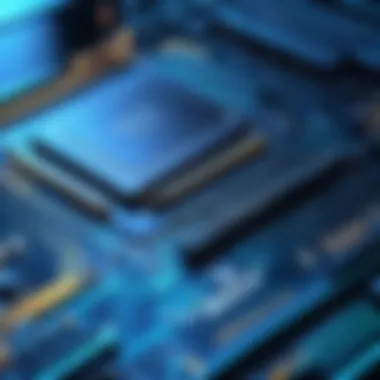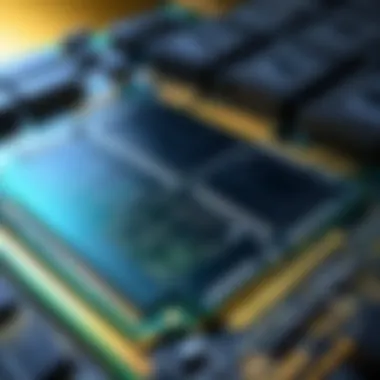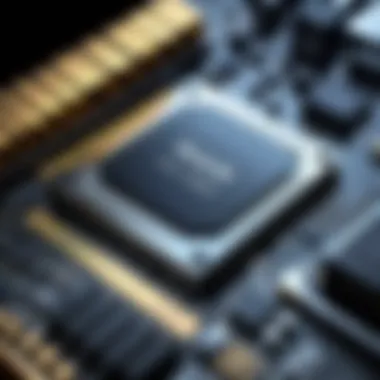Unraveling the Distinctions Between Cache Memory and RAM


As we delve into the realms of computing architecture, one cannot overlook the critical components of cache memory and RAM. These two elements form the bedrock of system performance, each playing a distinct yet interconnected role in the seamless operation of computers. While cache memory is like a swift and supercharged courier, deftly delivering frequently accessed data to the CPU at lightning speed, RAM acts as the reliable work desk holding transient information for instant retrieval. Therefore, understanding the disparities between cache memory and RAM is paramount in comprehending the intricate orchestration that powers our digital devices.
- Key Points to be Discussed
- Relevance of the Topic
- Definition and Function of Cache Memory
- Definition and Role of RAM
- Variances in Access Speed and Capacity
- Impact on System Performance
- Enhancing System Efficiency and Speed
- Optimizing Resource Allocation
- Improving User Experience
Prologue
Cache memory and RAM are fundamental components in computer systems, intricately involved in enhancing overall performance. By delving into the nuances of these elements, readers can grasp their functionality better and understand how they play a pivotal role in optimizing system operations.
Definition of Cache Memory and RAM
Cache Memory Overview
Cache memory, a high-speed storage component integrated into the CPU, plays a crucial role in preemptively storing frequently accessed data. Its proximity to the CPU ensures rapid access times, significantly boosting system responsiveness. One key characteristic of cache memory is its ability to reduce latency by providing quick access to instructions and data, thereby enhancing the system's efficiency. Despite its advantages, the limited capacity of cache memory poses a challenge, requiring intelligent algorithms to manage data effectively.
RAM Overview
Random Access Memory (RAM) serves as volatile memory in a computer system, holding data that the CPU needs to access quickly. Unlike cache memory, RAM has a larger storage capacity but operates at a slower speed. Its key characteristic lies in offering temporary storage for active programs and data, facilitating multitasking and overall system responsiveness. However, the volatility of RAM necessitates regular data transfers to and from secondary storage, impacting performance.
Importance of Cache Memory and RAM
Cache Memory Significance
Cache memory's significance stems from its ability to accelerate system performance by storing frequently accessed data closer to the CPU, minimizing latency. This feature is particularly beneficial for tasks requiring quick data retrieval and computation, improving overall system responsiveness. However, the limited capacity of cache memory demands efficient management strategies to ensure optimal utilization and performance.
RAM Significance
RAM holds a critical position in system operations by providing temporary storage for active programs and data, enabling quick access for the CPU. Its significance lies in supporting multitasking capabilities and enhancing user experience through efficient data handling. Despite its advantages, the volatility of RAM necessitates data backups and introduces complexities in managing system memory effectively.
Technical Comparison


Why is the technical comparison between cache memory and RAM crucial in this comprehensive discussion? Well, diving into the technical aspects provides a deeper understanding of the intricacies that differentiate these essential computer components. By examining the architecture variances, access speeds, and storage capacities, enthusiasts and professionals can grasp the nuanced differences that impact system performance significantly. Through a meticulous analysis of these technical dimensions, individuals in the IT field can make informed decisions regarding hardware optimization and configuration.
Architecture Variances
Cache Memory Architecture
When exploring the specifics of cache memory architecture, one must consider its role in optimizing system performance. The cache memory architecture emphasizes proximity to the CPU, allowing for rapid data access and retrieval. This closeness facilitates quick access to frequently used instructions and data, enhancing processing efficiency. The unique feature of cache memory architecture lies in its ability to store small amounts of data directly on the CPU, reducing latency and boosting operational speed. While advantageous in improving processing speeds, the limited capacity of cache memory may necessitate strategic data management to maximize its benefits in a given system.
RAM Architecture
Turning attention to RAM architecture, it becomes apparent how this component contributes to overall system functionality. RAM architecture focuses on providing temporary storage for data that the CPU needs to access quickly. The key characteristic of RAM architecture lies in its capacity to hold larger amounts of data compared to cache memory, offering more significant storage capabilities for applications and processes. This unique feature ensures that real-time data requirements are met efficiently, supporting seamless multitasking and overall system responsiveness. Despite its advantages in accommodating more extensive datasets, RAM's slightly slower access speeds compared to cache memory require a careful balance between capacity and speed optimization to ensure optimal system performance.
Access Speeds
Cache Memory Speed
Delving into the realm of cache memory speed sheds light on its impact on system operations. Cache memory speed is renowned for its exceptional velocity in delivering data to the CPU. This rapid access contributes to minimized latency and expedites processing tasks, making cache memory an invaluable component for high-performance computing environments. The unique feature of cache memory speed lies in its ability to synchronize data delivery with the CPU's processing requirements, ensuring seamless data flow and reduced idle time. While advantageous for boosting system responsiveness, the limited capacity of cache memory necessitates efficient data prioritization strategies to capitalize on its speed benefits effectively.
RAM Speed
In contrast, RAM speed plays a vital role in supporting continuous data access within a system. The key characteristic of RAM speed centers on providing a balance between data transfer rates and storage capacity. This balance enables RAM to handle a wide range of data processing requirements efficiently, catering to diverse application needs seamlessly. The unique feature of RAM speed is its adaptability to varying workloads, ensuring consistent performance across different computational tasks. While offering greater storage capabilities than cache memory, the slightly slower speed of RAM necessitates intelligent data caching mechanisms to optimize data retrieval and utilization effectively.
Storage Capacity
Cache Memory Capacity
The realm of cache memory capacity delves into its ability to hold a small yet highly impactful volume of frequently accessed data. Cache memory capacity prioritizes storing data that the CPU requires imminently, enhancing processing efficiency and reducing data retrieval times. The key characteristic of cache memory capacity lies in its rapid data access capabilities, making it an ideal choice for storing time-sensitive and critical information. This unique feature allows cache memory to streamline data processing and enable swift execution of instructions, improving overall system responsiveness. Despite its limited storage capacity, cache memory's quick access speeds make it a valuable asset for optimizing system performance in demanding computing environments.
RAM Capacity
On the other hand, RAM capacity focuses on providing substantial storage space for diverse data needs within a system. The key characteristic of RAM capacity is its ability to accommodate extensive datasets that require frequent access and manipulation. This capacity ensures that multiple applications and processes can access data concurrently, supporting seamless multitasking capabilities. The unique feature of RAM capacity lies in its adaptability to fluctuating workload demands, making it a versatile option for handling dynamic computational requirements. While offering larger storage capacities than cache memory, the slightly slower data retrieval speeds of RAM necessitate efficient data organization and utilization strategies to maintain optimal system performance.
Functional Variances (Outer Section)
Functional Variances play a pivotal role in elucidating the disparities between cache memory and RAM within the realm of computer systems. Understanding the functional disparities between these components is paramount for grasping their distinct contributions to system performance and efficiency. Delving into the intricate details of functional variances provides a comprehensive view of how cache memory and RAM operate uniquely within the confines of a computing environment, shedding light on their individual significance.


Role in System Performance (Inner Section)
Cache Memory Functionality
In dissecting the nuances of system performance, the functionality of cache memory emerges as a crucial element in bolstering operational speed and efficiency. The key characteristic of cache memory functionality lies in its ability to store frequently accessed data closer to the CPU, thereby reducing retrieval times and enhancing overall system performance. This particular feature makes cache memory a preferred choice in scenarios demanding rapid data access and streamlined operations. Furthermore, the unique feature of cache memory functionality lies in its efficient handling of temporary data storage, offering advantages in terms of quick data retrieval while potentially facing limitations in storage capacity.
RAM Functionality
Conversely, the functionality exhibited by Random Access Memory (RAM) contributes significantly to the overarching goal of boosting system performance. RAM's key characteristic revolves around providing temporary storage for data that the CPU is actively processing, ensuring swift access to information during operations. This feature renders RAM a popular choice for applications requiring dynamic data allocation and fast read/write speeds. The unique feature of RAM functionality lies in its support for multitasking capabilities, allowing seamless data handling across diverse processes but can face constraints in size and cost efficiency.
Data Handling (Inner Section)
Cache Memory Process
Exploring the intricacies of data handling, the cache memory process emerges as a pivotal component influencing system functionality. The key characteristic of cache memory processing lies in its swift data retrieval mechanism, which expedites computational tasks by preemptively storing frequently accessed data. This characteristic positions cache memory as an advantageous choice for improving overall system performance through optimized data access times. Additionally, the unique feature of cache memory processing resides in its efficient data caching strategy, offering faster access speeds while potentially encountering limitations in storage capacity.
RAM Process
On the other hand, the process inherent to Random Access Memory (RAM) plays a significant role in data manipulation within a computing environment. RAM's key characteristic lies in its ability to provide rapid data access to the CPU for real-time processing requirements, ensuring smooth functionality during various computing operations. This fundamental aspect makes RAM a favored option for applications necessitating dynamic data storage and retrieval, facilitating efficient data processing. The unique feature of RAM processing lies in its volatile nature, enabling quick data read/write capabilities essential for real-time computing tasks but potentially posing challenges in long-term data retention.
Interaction with CPU (Inner Section)
Cache Memory Communication
The mode of communication established by cache memory holds substantial sway over its integration with the central processing unit (CPU) within a computer system. The key characteristic of cache memory communication centers around its direct and rapid interaction with the CPU, facilitating quick data exchanges and minimized latency in data retrieval processes. This inherent characteristic makes cache memory communication an advantageous option for enhancing system speed and performance. Moreover, the unique feature of cache memory communication lies in its aptitude for seamless data transfer, allowing efficient collaboration between the cache memory and CPU, albeit potentially encountering limitations in capacity.
RAM Communication
In contrast, the communication protocol adopted by Random Access Memory (RAM) plays a crucial role in dictating its interoperability with the CPU in a computing setup. RAM's key characteristic pertains to its reliable and consistent communication with the CPU, ensuring uninterrupted data flow for ongoing computational tasks. This key feature positions RAM as an indispensable element for smooth data transmission and processing within a computer system. The unique feature of RAM communication revolves around its synchronous data transfer capability, enabling efficient information sharing between RAM and CPU instances, although it may present constraints in terms of latency and bandwidth resources.
Usage Scenarios
In dissecting the variances between cache memory and RAM, the consideration of usage scenarios stands as a pivotal segment. The strategic utilization of these components within diverse contexts underlines their significance in optimizing system functionality. Understanding the scenarios where cache memory and RAM excel is key to enhancing overall system performance. This emphasis on practical implementation fosters a comprehensive grasp of the operational dynamics inherent in modern computer systems.


Optimal Use Cases
Cache Memory Scenarios
Delving into cache memory scenarios sheds light on its specialized applications in system operation. The unique feature of cache memory scenarios lies in their ability to swiftly retrieve frequently accessed data, augmenting processing speeds significantly. This agility in data access proves particularly advantageous in scenarios where real-time data processing is imperative. However, the limitation in storage capacity presents a potential drawback, especially in scenarios requiring vast data repositories. Despite this, the efficiency in data retrieval renders cache memory scenarios a favored choice in scenarios demanding rapid data access.
RAM Scenarios
Exploring RAM scenarios illuminates its role in supporting a system's volatile memory requirements. The key characteristic of RAM scenarios lies in their capacity to store data temporarily for immediate processing by the CPU. This swift data transfer capability makes RAM a popular choice in scenarios necessitating frequent and rapid data manipulation. One notable advantage of RAM scenarios is the ability to handle large volumes of data simultaneously, enhancing multitasking capabilities. Nevertheless, the volatility of RAM necessitates continuous power supply, posing a risk of data loss in case of power failure. Despite this, the rapid data processing capabilities render RAM scenarios an indispensable asset in scenarios demanding high-speed data operations.
Performance Impact
In evaluating the impact of cache memory and RAM on system performance, exploring their respective effects becomes paramount. The distinct characteristics of these components exert varying degrees of influence on overall system efficiency, shaping the operational outcomes significantly.
Cache Memory Effects
The realm of cache memory effects encompasses its role in minimizing latency and optimizing CPU performance. The key characteristic of cache memory effects lies in their ability to expedite data retrieval processes, reducing wait times substantially. This acceleration in data access enhances the overall system responsiveness, particularly in tasks requiring frequent data access. However, the limited storage capacity of cache memory may lead to data evictions, impacting performance in scenarios exceeding cache capacity. Despite this, the unparalleled speed of data retrieval substantiates cache memory effects as a beneficial choice in scenarios necessitating rapid data processing.
RAM Effects
Exploration of RAM effects sheds light on its impact on system performance and multitasking capabilities. The central feature of RAM effects is the facilitation of seamless data storage and retrieval, enabling efficient multitasking operations. This ability to store and access data swiftly enhances system responsiveness, especially in scenarios necessitating simultaneous execution of multiple applications. However, the volatile nature of RAM requires constant power supply for data retention, posing potential data loss risks in power outage situations. Yet, the unmatched data handling capabilities of RAM effects position RAM as an indispensable element in scenarios requiring high-speed data operations and multitasking functionalities.
Closure
Cache memory and RAM play pivotal roles in a computer system's performance. Understanding the differences is crucial to optimizing system functionality effectively. By delving into the nuances of cache memory and RAM, readers gain insight into their specific functions and how they complement each other in enhancing overall performance.
Summary of Differences
Cache Memory Recap
Cache memory serves as a high-speed buffer between the CPU and main memory, storing frequently accessed data for quicker retrieval. Its small size and proximity to the CPU allow for rapid access, significantly boosting processing speeds. Despite its efficiency, cache memory has limited capacity, leading to frequent data cycling for optimal performance.
RAM Recap
Random Access Memory (RAM) is the main memory component where data is temporarily stored for the CPU to access quickly. Unlike cache memory, RAM has larger storage capacity but slower access speeds. It acts as a bridge between the CPU and hard drive, facilitating data transfer and enabling multitasking. While RAM enhances overall system performance, limitations in speed can impact real-time operations.
Final Thoughts
Implementing Cache Memory and RAM
Implementing cache memory and RAM strategically is vital for system optimization. By balancing the speed of cache memory with the storage capacity of RAM, computer systems can achieve peak performance levels. Efficient communication between cache memory, RAM, and the CPU is critical for seamless data handling and smooth functionalities. Careful consideration of the advantages and disadvantages of each component is essential to harnessing their full potential for system efficiency.



